|
One of the methods of this
millennia old tradition originating in ancient Persia was
“club swinging.” The
Clubbell resurrects the centuries proven
tradition of swinging weight in three dimensions rather than
lifting it in only one or two.
I was exposed to Clubbells by
Bruce Pahl of
Immortal Martial Arts
recently while picking up my
battling rope. I really
found the variety of movements and exercises to be a
refreshing challenge that I wanted to find out more about.
Unlike conventional
weight-lifting, where you must increase the weight lifted, the
Clubbell is swung. Swinging weight increases torque.
Increasing torque increases force production.
Clubbell training increases
force exponentially: swinging them twice as fast produces four
times the torque. Superior force production means
superior strength conditioning in a fraction of the time and
without the litany of injuries associated with conventional
weight training. Traction pulls apart the joints, rather than
compressing them which increases connective tissue strength.
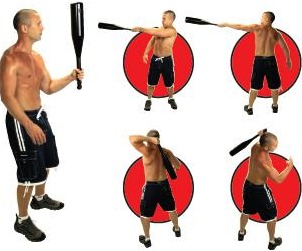
The obvious benefits of Clubbell
training include the development of the arms, shoulders, upper
back and chest. However, the most misunderstood difference
between Circular Strength Training (Clubbells) and
conventional weight-lifting is that the Clubbell is
specifically designed to connect the superior force production
of torque to one's core. Furthermore, all exercises are
full bodily intensive: creating incredibly powerful glutes,
hams, quads and calves from the leg drive.
Circular Strength Training
comprises three dimensional strength
(tri-planar movements) which develop rotary and
angular/diagonal strength to assist the prime movers.
Developing tri-planar strength of the prime movers increases
stability, enhances injury prevention, multiplies force
production abilities and most importantly, stimulates the
neuromuscular patterns required of athletes.
With dumbbells, the weight can
be supported by your skeletal structure, as if sitting on top
of a column. With dumbbells your grip is located directly upon
the center of gravity which remains constant throughout the
exercise for the entire range of motion. The Unique
Balance Scheme of Clubbells forces athletes to use proper
technique and concentrate on complex skills during the
movement. The Displaced Center of Gravity forces you to
keep the weight inside of its proper groove throughout the
entire lift.
One of the single most defining
characteristics of athletic performance in sports especially
contact sports and tool-using sports, is grip strength &
endurance which elite coaches consider the measuring stick of
one’s total functional strength. However, most strength
programs overlook hand, wrist and forearm conditioning.
Due to the displaced center of gravity and the effect on hand
and grip strength, Clubbells present very functional and
challenging exercises for grip and hand strength.
__________________________________________________
Do-it-yourself
Clubbell design
Although you can pick up a club or
two from the
Clubbell website, I was able to find plans for a
do-it-yourself club on the internet... here's a link to the
YouTube video.
This
design can be used as an adjustable clubbell, allowing weights between 9
and 13 lbs. In the 3rd picture you can see the series of pipes that
I use that fit inside the main pipe. I used some duct tape around
the ends of the pipes, as well as some rubber matting in the cap, to
prevent the movement and clanging from the pipes shifting during
movement.
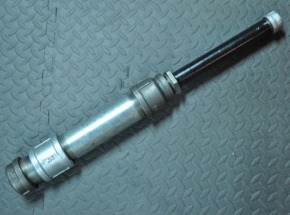
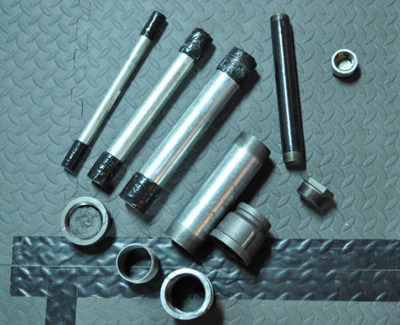
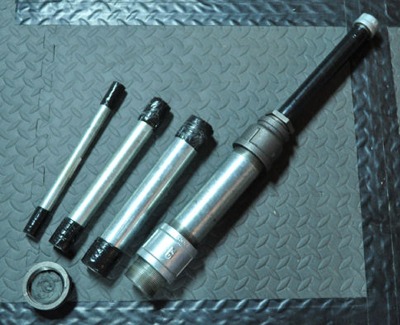
Parts (main pipe):
-
1: 1" steel nipple end cap.
-
1: 10" x 1" steel nipple pipe.
-
1: 1.5"-1" steel nipple bushing
-
1: 2"-1.5" steel nipple reducer
-
1: 8" x 2" steel nipple pipe
-
1: 2" steel nipple coupling connector
-
1: 2" x 2" steel nipple pipe
-
1:
2" steel nipple end cap.
Parts (inside weight pipes - fit inside each other):
-
12"
x 1.5" steel nipple pipe
-
12"
x 1" steel nipple pipe
-
12"
x .5" steel nipple pipe
UPDATE
(grip alternative)
I've had challenges in the past
with some of the grips that I've had to design for some of my
fitness equipment. I've tried athletic tape, baseball
bat grip tape, and some pretty expensive rubberized grip tape
for lacrosse sticks. Most of these tape grips start out
pretty good, but after some time they get all curled up and
start getting uncomfortable. This was a problem
that I was battling with my homemade clubbells.
I
was at Home Depot the other day and found this stuff called
Plasti Dip. It's a rubberized paint that comes in a
tube with a pop-top lid. It's intended for the handles
of pliers, screwdrivers, and related hand tools. For
most applications you just dip the tools right in the Plasti
Dip container, however, I had to get creative with my
clubbells, since the handles were longer than the Plasti Dip
tube. So by using a length of PVC pipe with a cap on
it, I was able to dip the pipe handle of the clubbell in a
few times to evenly coat the entire handle.
I'd have to say that the
rubberized grip of the Plasti Dip handles feels very
comfortable and it appears to meet my needs. I've been
swinging the clubbells for a week now and there are no signs
of wear or degradation. One tube of Plasti Dip is just
under $6, so really not bad in comparison to the tapes that
require replacement somewhat frequently. Give it a
shot!
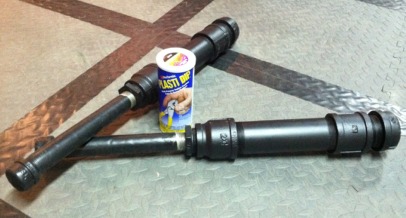
|
![]()